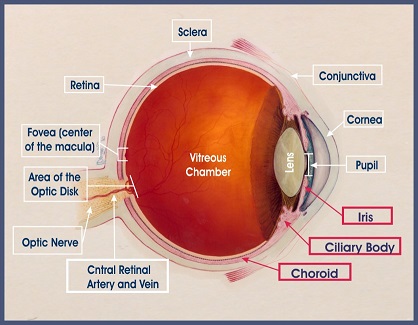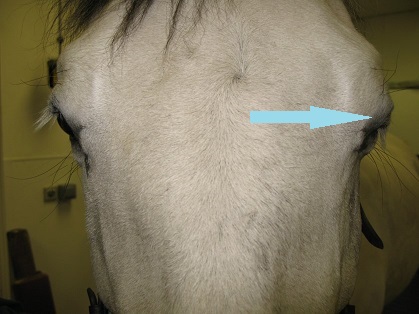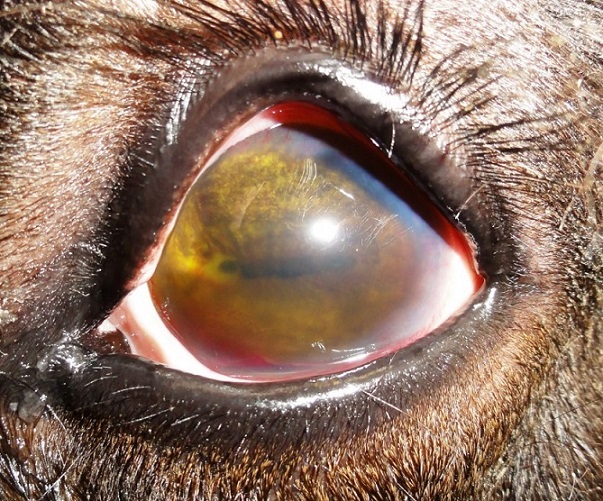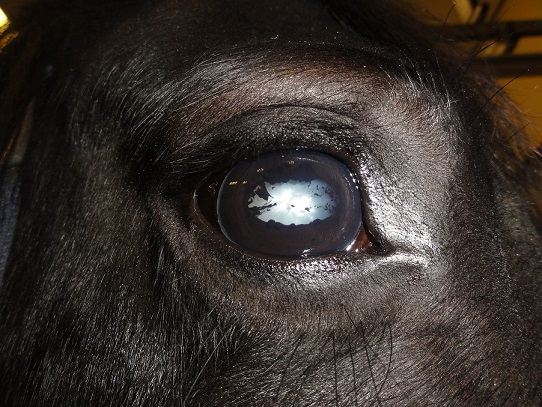Uveitis
What is uveitis?
Uveitis means inflammation of the uvea, one of the layers of the eye. This layer contains most of the blood supply to the eye and includes three structures: the iris (the part of the eye that determines the colour of the eye), the ciliary body and the choroid.

Uveitis is the leading cause of blindness in horses and a very common cause of chronic ocular pain in horses.
What causes uveitis?
Uveitis in horses can occur secondary to any eye problem, for example after trauma to the eye or as a consequence of a corneal ulcer. In these cases the uveitis tends to get under control when the primary problem is treated
But primary uveitis can also occur. The reasons why this happens are not completely understood. Studies in America and mainland Europe have shown that often this is caused following infection with a bacteria called Leptospira, either by directly infecting the eye or by altering the immune system inside the eye. However, research carried out at the University of Liverpool showed that this doesn’t seem to be the leading cause of uveitis in the UK.
In addition, there seems to be a genetic component to the disease, with certain breeds, particularly Appaloosa, at increased risk of developing the disease
Signs of uveitis
The first thing you may notice in a horse with uveitis is ocular pain, demonstrated by your horse closing his eye and producing some ocular discharge. The easiest thing to note if your horse has mild pain is to look from the front and check the angle of the eyelashes; you will notice that this angle drops in the painful eye (see arrow in picture below)

Uveitis can be divided in anterior or posterior uveitis, depending which structures of the uvea are affected, or both at the same type (panuveitis)
Ocular signs frequently observed in acute anterior uveitis cases are chemosis (injection of the blood vessels around the eye), miosis (closed pupil) and aqueous flare (milky appearance to the inside of the eye). The iris may take a green-yellowish appearance. On occasions there may be blood, pus or fibrin inside the eye (see picture below).

Posterior uveitis is a lot more subtle and can go unnoticed for months, with only very mild ocular pain that is frequently missed until the condition become chronic.
In any case, uveitis can become chronic and recur at regular intervals, a syndrome called equine recurrent uveitis (ERU). With every new episode of inflammation more and more damage is done to the eye. Some long term consequences of recurrent uveitis are damage to the iris, cataracts, glaucoma and retinal detachment, with very serious implications in horses’ vision. The picture below shows a horse with chronic uveitis, with a very dense cataract and a ragged edge to the iris

Consequences of uveitis
Uveitis is the leading cause of blindness in horses. A recent study from the USA showed that almost 30% of horses are already blind in the affected eye by the time they are first presented to a vet for examination. Therefore it is vital that your horse’s eyes are examined if you have any concerns about them.
This study also showed that around 30% of horses with uveitis had to be retired due to the condition, and another 30% performed at a reduced level than before the disease started.
Sadly, 15% of horses had to be euthanased due to bilateral blindness or chronic, uncontrollable pain.
Treatment of uveitis
The main purpose of the treatment in a case of acute uveitis is two-fold: treat the ocular pain and control the inflammation.
To treat the pain we use painkillers (such as bute or flunixin) and also a drug called atropine. The action of the atropine is to open the pupil again (this provides relief of the pain and also prevents secondary complications that can happen when the pupil remains closed for a long period)
To control the inflammation we use a combination of steroidal (typically with eye drops) and non-steroidal anti-inflammatories (normally bute or flunixin).
Although an eye may respond well to treatment and show a good improvement, we would recommend continuing the therapy for a number of weeks to prevent the disease from becoming chronic.
Unfortunately some of the cases do become chronic and episodes of uveitis recur at regular intervals. You may choose to treat the episodes with the drugs and eye-drops every time an episode of uveitis happens. However, for these cases there are surgical options available such as suprachoroidal cyclosporine implants or pars plana vitrectomy. And also, new treatments that are currently experimental should become available over the next few years (for example, intrachoroidal injections of steroids).
Unfortunately, despite these treatment options, some eyes fail to respond to any therapy and require enucleation to remove the constant source of pain.
Preventing uveitis
It is difficult to prevent the first episode of uveitis so the most important thing is to make sure that this first episode is rapidly identified and treated aggressively. Therefore if you have any concerns about your horse’s eye you should have it checked immediately.
If your horse has chronic, recurrent uveitis it is advisable to protect the eye as much as possible and avoid exposure to excess UV light, for example by making your horse wear a fly or UV mask.
There is a genetic test available for Appaloosa horses to be able to determine what is the risk of your horse developing uveitis in the future.